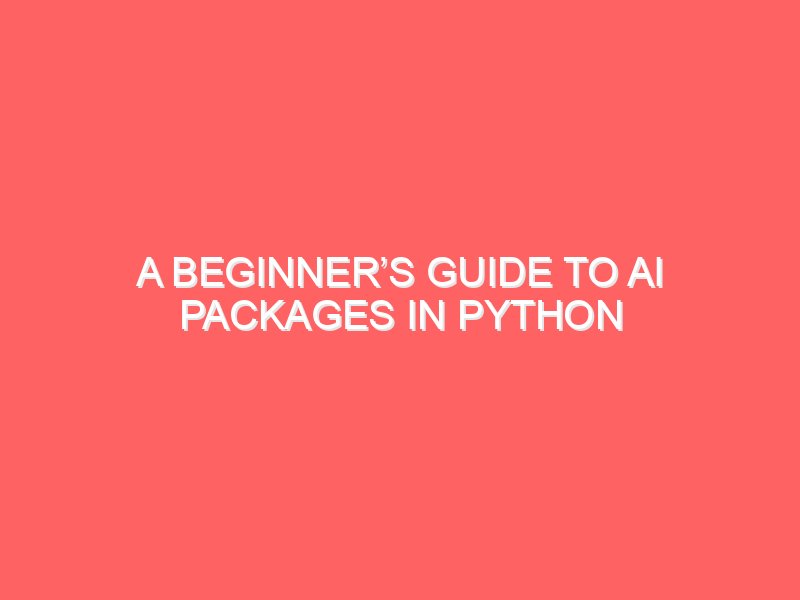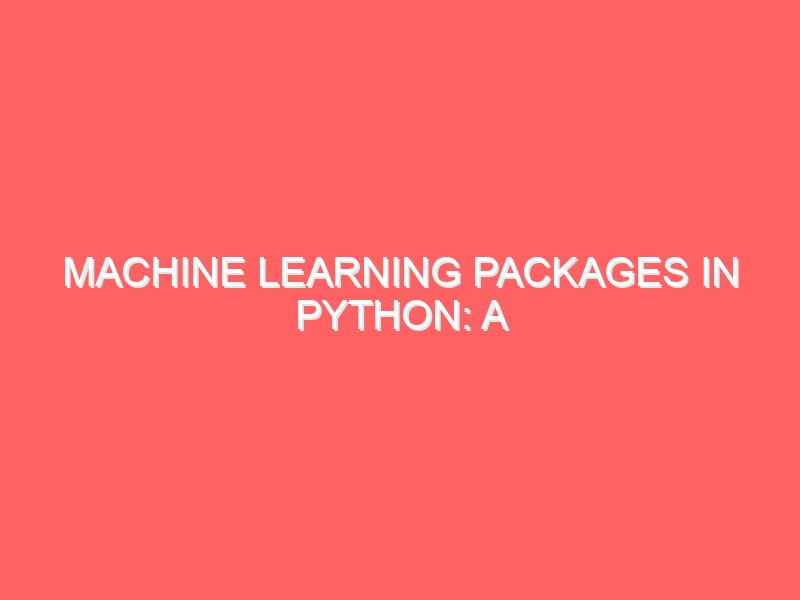Python has become the go-to language for artificial intelligence (AI) and machine learning (ML) enthusiasts. Its simplicity and extensive libraries make it a favorite among developers, data scientists, and hobbyists alike. Whether you are a seasoned programmer or just starting your coding journey, diving into AI with Python can be both exciting and rewarding. In this blog post, we’ll explore some of the most popular AI packages in Python, focusing on how they can help you create intelligent systems and solutions. If you’re looking for python training or are interested in learning to code in Ranchi, Emancipation Edutech has you covered.
1. Introduction to Python for AI
Why Python for AI?
Python’s readability and simplicity make it an ideal language for beginners and experts alike. Its syntax is easy to learn, which means you can focus more on solving problems rather than worrying about the complexities of the language itself. Moreover, Python boasts a vast ecosystem of libraries and frameworks tailored for AI and ML, making the development process more efficient and enjoyable.
Getting Started with Python
Before diving into AI-specific packages, you need to have Python installed on your system. You can download it from the official Python website. Once installed, you can start writing Python code using any text editor or an Integrated Development Environment (IDE) like PyCharm, Visual Studio Code, or Jupyter Notebook.
At Emancipation Edutech, we offer comprehensive python training that covers everything from basic syntax to advanced topics, ensuring you have a solid foundation to build upon.
2. NumPy: The Foundation of AI and ML
What is NumPy?
NumPy, short for Numerical Python, is a fundamental package for scientific computing in Python. It provides support for large, multi-dimensional arrays and matrices, along with a collection of mathematical functions to operate on these arrays.
Installing and Using NumPy
To install NumPy, you can use pip, the Python package manager:
pip install numpyHere’s a basic example of how NumPy works:
import numpy as np
# Creating a NumPy array
array = np.array([1, 2, 3, 4, 5])
# Performing basic operations
print("Array:", array)
print("Mean:", np.mean(array))
print("Sum:", np.sum(array))NumPy is essential for data manipulation and serves as the backbone for many other AI and ML libraries.
Real-world Applications
NumPy is widely used in various fields such as finance, physics, and data science. It helps in performing complex mathematical calculations efficiently, which is crucial for AI and ML tasks.
3. Pandas: Data Manipulation Made Easy
What is Pandas?
Pandas is an open-source data manipulation and analysis library for Python. It provides data structures and functions needed to manipulate structured data seamlessly.
Installing and Using Pandas
To install Pandas, use pip:
pip install pandasHere’s a simple example to get you started:
import pandas as pd
# Creating a DataFrame
data = {'Name': ['John', 'Anna', 'Peter', 'Linda'],
'Age': [28, 24, 35, 32]}
df = pd.DataFrame(data)
# Displaying the DataFrame
print(df)
# Basic operations
print("Mean Age:", df['Age'].mean())
print("Number of Entries:", df['Name'].count())Why Pandas?
Pandas is particularly useful for data wrangling and preparation, which are crucial steps in any AI or ML project. It allows you to clean, analyze, and visualize data efficiently, making it a vital tool in your AI toolkit.
At Emancipation Edutech, our python training courses include hands-on experience with Pandas, ensuring you can handle real-world data with ease.
4. Scikit-Learn: Your First Step into Machine Learning
What is Scikit-Learn?
Scikit-Learn is a powerful Python library for machine learning. It provides simple and efficient tools for data mining and data analysis, built on NumPy, SciPy, and matplotlib.
Installing and Using Scikit-Learn
To install Scikit-Learn, use pip:
pip install scikit-learnHere’s an example of how to use Scikit-Learn to perform a basic classification task:
from sklearn.datasets import load_iris
from sklearn.model_selection import train_test_split
from sklearn.neighbors import KNeighborsClassifier
from sklearn.metrics import accuracy_score
# Loading the iris dataset
iris = load_iris()
X = iris.data
y = iris.target
# Splitting the data into training and testing sets
X_train, X_test, y_train, y_test = train_test_split(X, y, test_size=0.2, random_state=42)
# Creating and training the model
model = KNeighborsClassifier(n_neighbors=3)
model.fit(X_train, y_train)
# Making predictions
predictions = model.predict(X_test)
# Evaluating the model
print("Accuracy:", accuracy_score(y_test, predictions))Why Scikit-Learn?
Scikit-Learn is user-friendly and integrates well with other libraries like NumPy and Pandas. It covers a wide range of machine learning algorithms, making it a versatile tool for various AI tasks.
Real-world Applications
Scikit-Learn is used in numerous applications, from spam detection to recommendation systems. It allows you to quickly prototype and deploy machine learning models.
5. TensorFlow and Keras: Deep Learning Made Simple
What are TensorFlow and Keras?
TensorFlow is an open-source library developed by Google for deep learning. It provides a comprehensive ecosystem for building and deploying machine learning models. Keras, on the other hand, is a high-level API for building neural networks, running on top of TensorFlow (and other backends).
Installing and Using TensorFlow and Keras
To install TensorFlow, use pip:
pip install tensorflowKeras is included in the TensorFlow package, so you don’t need to install it separately. Here’s a basic example to build a neural network using Keras:
import tensorflow as tf
from tensorflow.keras.models import Sequential
from tensorflow.keras.layers import Dense
# Creating a simple neural network
model = Sequential([
Dense(128, activation='relu', input_shape=(784,)),
Dense(64, activation='relu'),
Dense(10, activation='softmax')
])
# Compiling the model
model.compile(optimizer='adam', loss='sparse_categorical_crossentropy', metrics=['accuracy'])
# Summary of the model
model.summary()Why TensorFlow and Keras?
TensorFlow and Keras are powerful tools for building complex neural networks. They offer flexibility and scalability, making them suitable for both research and production environments.
Real-world Applications
TensorFlow and Keras are used in various applications, such as image and speech recognition, natural language processing, and autonomous driving. Their ability to handle large-scale data and complex models makes them indispensable in the AI landscape.
6. NLTK and SpaCy: Natural Language Processing (NLP) Essentials
What are NLTK and SpaCy?
Natural Language Toolkit (NLTK) and SpaCy are two popular libraries for natural language processing (NLP) in Python. NLTK is a comprehensive library for working with human language data, while SpaCy is designed for industrial-strength NLP tasks.
Installing and Using NLTK and SpaCy
To install NLTK, use pip:
pip install nltkFor SpaCy, use pip and download a language model:
pip install spacy
python -m spacy download en_core_web_smHere’s a basic example of text processing with NLTK:
import nltk
from nltk.tokenize import word_tokenize
# Downloading necessary NLTK data
nltk.download('punkt')
# Tokenizing text
text = "Hello world! Welcome to the world of NLP."
tokens = word_tokenize(text)
print("Tokens:", tokens)And with SpaCy:
import spacy
# Loading the SpaCy model
nlp = spacy.load("en_core_web_sm")
# Processing text
doc = nlp("Hello world! Welcome to the world of NLP.")
for token in doc:
print(token.text, token.pos_, token.dep_)Why NLTK and SpaCy?
NLTK is great for learning and prototyping NLP tasks, while SpaCy is optimized for performance and production use. They complement each other and provide a robust toolkit for NLP.
Real-world Applications
NLP is used in various applications such as chatbots, sentiment analysis, and machine translation. NLTK and SpaCy enable you to preprocess, analyze, and understand text data effectively.
7. PyTorch: Flexible and Dynamic Deep Learning
What is PyTorch?
PyTorch is an open-source deep learning library developed by Facebook. It is known for its dynamic computational graph and ease of use, making it a favorite among researchers and developers.
Installing and Using PyTorch
To install PyTorch, follow the instructions on the official PyTorch website. Here’s a simple example of how to use PyTorch:
import torch
import torch.nn as nn
import torch.optim as optim
# Creating a simple neural network
class SimpleNN(nn.Module):
def __init__(self):
super(SimpleNN, self).__init__()
self.fc1 = nn.Linear(784, 128)
self.fc2 = nn.Linear(128, 64)
self.fc
3 = nn.Linear(64, 10)
def forward(self, x):
x = torch.relu(self.fc1(x))
x = torch.relu(self.fc2(x))
x = torch.log_softmax(self.fc3(x), dim=1)
return x
# Initializing the network, loss function, and optimizer
model = SimpleNN()
criterion = nn.NLLLoss()
optimizer = optim.Adam(model.parameters(), lr=0.001)
# Summary of the model
print(model)Why PyTorch?
PyTorch offers greater flexibility and a more intuitive approach to model building compared to other frameworks. Its dynamic computational graph allows you to modify the network on the fly, which is particularly useful for research and experimentation.
Real-world Applications
PyTorch is used in various cutting-edge AI applications, including natural language processing, computer vision, and reinforcement learning. Its flexibility and performance make it a top choice for both academia and industry.
8. OpenCV: Bringing AI to Computer Vision
What is OpenCV?
OpenCV (Open Source Computer Vision Library) is an open-source computer vision and machine learning software library. It provides a common infrastructure for computer vision applications and accelerates the use of machine perception in commercial products.
Installing and Using OpenCV
To install OpenCV, use pip:
pip install opencv-pythonHere’s a basic example to read and display an image using OpenCV:
import cv2
# Reading an image
image = cv2.imread('path/to/your/image.jpg')
# Displaying the image
cv2.imshow('Image', image)
cv2.waitKey(0)
cv2.destroyAllWindows()Why OpenCV?
OpenCV is designed to be efficient and offers a comprehensive set of tools for image and video processing. It supports various algorithms related to computer vision, making it a valuable asset for AI projects.
Real-world Applications
OpenCV is widely used in applications like facial recognition, object detection, and augmented reality. Its ability to process images and videos in real-time makes it indispensable for many AI-driven solutions.
9. Conclusion: Your AI Journey Begins Here
Embarking on an AI journey with Python is both exciting and challenging. The libraries and frameworks we discussed—NumPy, Pandas, Scikit-Learn, TensorFlow, Keras, NLTK, SpaCy, PyTorch, and OpenCV—are powerful tools that can help you build intelligent systems and applications.
Whether you are looking to learn the basics or dive into advanced topics, python training at Emancipation Edutech can guide you every step of the way. Located in Ranchi, our comprehensive courses are designed to equip you with the skills needed to excel in the ever-evolving field of AI and ML.
Remember, the key to mastering AI is practice and persistence. So, start coding, experiment with these libraries, and bring your AI ideas to life. Happy coding!



